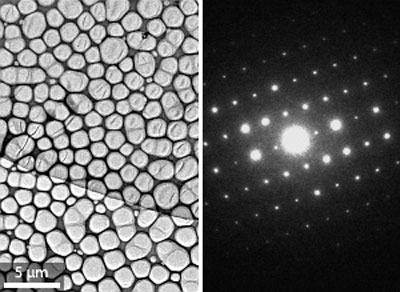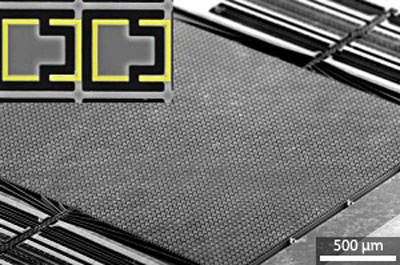It will perhaps be possible, in the near future, to detect cancer by a simple blood or urine test. In fact, biologists from CNRS, Inserm, Paris Descartes and Strasbourg universities have developed a technique capable of detecting minute traces of tumoral DNA present in the biological fluids of patients suffering from cancer. The method consists in carrying out ultra-sensitive molecular analyses in microscopic droplets.
May 23rd, 2011
Read more
 One of the most striking properties of graphene is arguably its two-dimensionality. The remarkable electronic behavior realized by this two-dimensionality has prompted researchers to try and form similar two-dimensional sheets from other materials. Wenping Hu and colleagues from the Beijing National Laboratory for Molecular Sciences in China have now succeeded in growing two-dimensional crystals of an organic semiconductor on large scales and on various types of substrate with a view to developing advanced organic electronic devices.
One of the most striking properties of graphene is arguably its two-dimensionality. The remarkable electronic behavior realized by this two-dimensionality has prompted researchers to try and form similar two-dimensional sheets from other materials. Wenping Hu and colleagues from the Beijing National Laboratory for Molecular Sciences in China have now succeeded in growing two-dimensional crystals of an organic semiconductor on large scales and on various types of substrate with a view to developing advanced organic electronic devices.
May 23rd, 2011
Read more
 The yellow hue of a series of samples from wall paintings in several Mayan archaeological sites can be attributed to the presence of indigoid compounds, including isatin and dehydroindigo, attached to palygorskite, a local phyllosilicate clay. SEM/EDX, TEM, UV/Vis spectroscopy, and voltammetry of microparticles show that the ancient Mayas could prepare indigo, Maya Blue, and "Maya Yellow" during successive stages.
The yellow hue of a series of samples from wall paintings in several Mayan archaeological sites can be attributed to the presence of indigoid compounds, including isatin and dehydroindigo, attached to palygorskite, a local phyllosilicate clay. SEM/EDX, TEM, UV/Vis spectroscopy, and voltammetry of microparticles show that the ancient Mayas could prepare indigo, Maya Blue, and "Maya Yellow" during successive stages.
May 23rd, 2011
Read more
 Ai-Qun Liu from Nanyang Technological University in Singapore and colleagues from Singapore, Taiwan, France and Hong Kong have prepared a metamaterial with optical properties that can be switched dynamically using micromachined actuators.
Ai-Qun Liu from Nanyang Technological University in Singapore and colleagues from Singapore, Taiwan, France and Hong Kong have prepared a metamaterial with optical properties that can be switched dynamically using micromachined actuators.
May 23rd, 2011
Read more
The physical forces that guide how cells migrate - how they manage to get from place to place in a coordinated fashion inside the living body - are poorly understood. Scientists have, for the first time, devised a way to measure these forces during collective cellular migration. Their surprising conclusion is that the cells fight it out, each pushing and pulling on its neighbors in a chaotic dance, yet together moving cooperatively toward their intended direction.
May 22nd, 2011
Read more
Researchers at the University of California, Los Angeles have discovered a way to "wake up" the immune system to fight cancer by delivering an immune system - stimulating protein in a nanoscale container called a vault directly into lung cancer tumors. The new method harnesses the body's natural defenses to fight disease growth.
May 20th, 2011
Read more
Chemical engineers at the Massachusetts Institute of Technology have designed a new type of drug-delivery nanoparticle that exploits a trait shared by almost all tumors: They are more acidic than healthy tissues. Such particles could target nearly any type of tumor, and can be designed to carry virtually any type of drug.
May 20th, 2011
Read more
A class of engineered nanoparticles - gold-centered spheres smaller than viruses - has been shown safe when administered by two alternative routes in a mouse study led by investigators at the Stanford University Medical School. This marks the first step up the ladder of toxicology studies that, within a year and a half, could yield to human trials of the tiny agents for detection of colorectal and possibly other cancers.
May 20th, 2011
Read more
Nanotechnology researchers have known for years that RNA, the cousin of DNA, is a promising tool for nanotherapy, but the difficulties of producing long-lasting, therapeutic RNA that remains stable and non-toxic while entering targeted cells have posed challenges for their progress. Now, in two papers published in the journal Molecular Therapy, a team of investigators details their method for producing RNA nanoparticles and testing their safety in the delivery of therapeutics to targeted cells.
May 20th, 2011
Read more
Melding nanotechnology and medical research, researchers from Sandia National Laboratories, the University of New Mexico, and the UNM Cancer Research and Treatment Center have produced an effective strategy that uses nanoparticles to treat tumors with a melange of anticancer agents. This strategy relies on using silica nanoparticles honeycombed with cavities that can store large amounts and varieties of drugs loaded inside a lipid-based nanoparticle known as a liposome.
May 20th, 2011
Read more
A team of investigators from Stanford University has developed a new biosensor microchip that could significantly speed up the process of drug development. The microchips, packed with highly sensitive magnetic nanosensors, analyze how proteins bind to one another, a critical step for evaluating the effectiveness and possible side effects of a potential medication.
May 20th, 2011
Read more
CRDF Global is soliciting applications from U.S. researchers in the field of nanotechnology to serve as subject matter experts and presenters at a 3-day workshop entitled "On the Frontiers of Nanotechnology: Research and Collaboration in the U.S. and Uzbekistan" in Tashkent, Uzbekistan on September 21-23, 2011.
May 20th, 2011
Read more
3-dimensional surfaces with features below 100 nanometres have numerous applications ranging from optics to life sciences. The development of new manufacturing processes, based on nanoimprinting techniques (NIL), is a core aspect for the success of these applications.
May 20th, 2011
Read more
Auf der Suche nach Materialien etwa fuer elektronische Bauteile koennen Physiker kuenftig einer neuen Spur folgen: Ein internationales Forscherteam hat zum ersten Mal praezise beobachtet, wie sich die physikalischen Eigenschaften einer Substanz - genauer gesagt des Metalloxids Lanthannickeloxid - aendern, wenn es in zweidimensionaler statt dreidimensionaler Form verarbeitet wird.
May 20th, 2011
Read more
 NVIDIA and the CGSociety, a division of Ballistic Media, have announced 'NVArt 6: Moving Innovation', a new worldwide digital art contest for artists to explore the future of electronic device design, with over $34,000 in prizes.
NVIDIA and the CGSociety, a division of Ballistic Media, have announced 'NVArt 6: Moving Innovation', a new worldwide digital art contest for artists to explore the future of electronic device design, with over $34,000 in prizes.
May 20th, 2011
Read more
Touch control, based on innovative large-area capacitive sensors, is enjoying exponential market growth. LOPE-C 2011 in Frankfurt, Germany, will present the state of the art and the trends of touch.
May 20th, 2011
Read more





 Subscribe to our Nanotechnology News feed
Subscribe to our Nanotechnology News feed